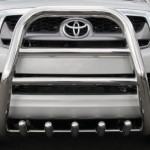Local Storage seems to be disabled in your browser.
For the best experience on our site, be sure to turn on Local Storage in your browser.
Why is it illegal to sell Bull Bars in the UK?
RoughTrax receives many customers enquiring about bull bars every day, and unfortunately we are unable to supply them. It is not our decision not to supply bull bars but an EU legislation preventing us from legally selling them without a pretty hefty fine.
We thought we would set the record straight and explain why it is now illegal to sell bull bars unless they been type approved, which is extremely costly.
What is a Bull Bar?
 Firstly let us explain what a bull bar is, a bull bar is also referred to as nudge bars, A-Bars or vehicle frontal protection systems. They originate from Australia where they are fitted to the front of cars and trucks to fend off (or nudge) large animals like bulls, kangaroos, wallabies, etc.
Firstly let us explain what a bull bar is, a bull bar is also referred to as nudge bars, A-Bars or vehicle frontal protection systems. They originate from Australia where they are fitted to the front of cars and trucks to fend off (or nudge) large animals like bulls, kangaroos, wallabies, etc.
Soon after the Ozzies began using them, they started to gain popularity over here in the UK. Why? Well, not because we needed to shift any wild animals, but because we thought they look pretty cool.
They are commonly fitted to Toyota 4x4's in the UK to protect a vehicle against front end impact to help minimize damage during a collision as well as the aesthetics.
Why are bull bars dangerous?
Bull bars may well protect the front of your truck from any damage that may occur as you can imagine, rigid steel bars can be pretty dangerous if you were to come into contact with another object. Because they are so solid, the bars transmit all the force to the object being hit, whereas a bumper or panel absorbs some of the force and crumples on impact.
Minor car-to-car collisions were made worse when bull bars were involved. Hit a pedestrian with them while travelling at speed, and the consequences could be fatal. According to research, around 250,000 pedestrians and cyclists were injured from bull bars each year, which isn’t great.
In 1994, the police collaborated with the Transport Research Laboratory to survey accidents involving bull-bar equipped vehicles, and this survey indicated that there were in that year about 2 or 3 additional fatalities and about 40 additional serious casualties as a result of vehicles being equipped with bull-bars.
These figures are more likely to be an under-estimate than an over-estimate. If there is a further increase in the number of vehicles fitted with aggressive bull-bars, the number of casualties can be expected to rise further. Which since 1994 this figure of course has risen significantly with the popularity of 4 wheel drives continually increasing.
What is EU Legislation?
An EU legislation is a law of the European Union member states. In May 2007, a new law came into effect which saw the banning of rigid bull bars. All new bars manufactured and fitted after then had to comply with stringent EU legislation. The bars produced nowadays are crash tested and considered to be much more ‘people friendly’ and instead of being called bull bars, they’re often referred to as ‘front protection bars’ or a ‘frontal protection system’ (FPS).
The ban isn’t retrospective, so if you’ve had bull bars fitted before the new law was passed, that’s OK. If you’re found to have illegal bars fitted to your truck, you could face a hefty fine. They could also make any insurance claim invalid if you were involved in an accident.
Can RoughTrax supply a bull bar?
Unfortunately not. As a supplier if we are found supplying anyone with a bull bar that do not conform to the EU legislation then the law can impose fines of up to £2,000 per bar or even imprisonment!
Having said that, companies are allowed to continue selling stock after the law was imposed providing that the stock being sold was purchased before the law was implemented, however as you can imagine RoughTrax stock was snapped up within days of the EU legislation coming into force.
Subsequent orders could not be placed for bars not conforming to the new standards, in fact the largest UK Manufacturer ceased production almost immediately. The end goal was for bull bars gradually being phased out which I guess if we look around nowadays this has happened. Don’t get me wrong, we were all in favour of supplying Bull Bars and in 2006 they were by far our best selling exterior accessory, we were not best pleased with this law.
We don’t fancy any run-ins with the law, and we gather that you don’t either. Plus, we can’t imagine there will be any huge roos' roaming our streets anytime soon.
What does Type-Approved mean?
All frontal protection systems must meet certain technical requirements where they were fitted to passenger cars and light commercial vehicles, the type approval system is very timely and expensive.
Bull bars need to absorb energy and the bar itself cannot, the brackets need to be designed to absorb the energy, in which case the brackets deflect allowing the bar to be pushed into the front of the vehicle so as not to cause excessive injury to pedestrians.
The requirement is to test for head impact within the 2005/66/EC regulation, although within Whole Vehicle Type Approval (WVTA), this regulation requires all bull bars systems to be tested for a head impact requirement, in all cases. This requires higher standards of compliance with a <18% risk of injury, in the head impact criteria.
To read the full research briefing from the very beginning, follow this link to view the parliamentary PDF file: www.researchbriefings.files.parliament.uk/documents/SN01216/SN01216.pdf
